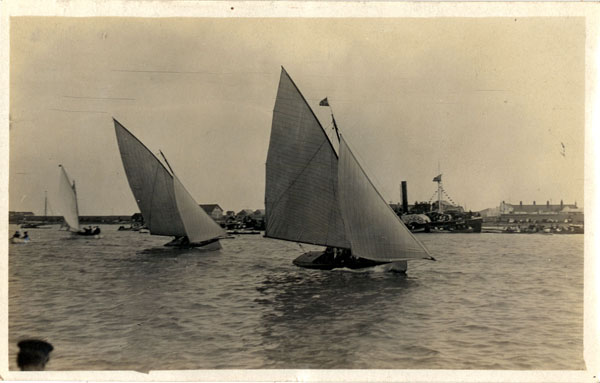Charles Francis (Frank) Rowe

Regatta at Shoreham
Stationer and photographer, 18 High Street and 32 Brunswick Road, Shoreham. Rowe acquired his High Street shop by 1903 and the shop in Brunswick Road by 1905. He continued to run his business at 18 High Street for nearly twenty years.
One of the first postcards that Rowe produced is a black and white halftone of "Bramber flood, 1904", labelled "F. Rowe, Shoreham". An example has been found posted at Shoreham in May 1904. Coloured halftone cards of the Shoreham area followed by 1905. These are labelled "Rowe's Shoreham Series" on the front, and under high magnification can be seen to have a dimpled surface, indented by tiny meandering depressions. Also around 1905, Rowe started selling some fine black and white collotypes of Shoreham with his name and address printed on the back.
Rowe was an energetic publisher of real photographic cards. One of his earliest real photographics records the wreck of the Liburna on March 15, 1905. Another interesting real photographic card shows the collapsed bank of the north wall of Southwick lock on April 16, 1907. The card at the head of this page records the sorry end of Major Bagnall's motor launch, which caught fire at sea off Shoreham in October 1910. The writer of the card (sent to R. Bagnall in Kettering) commented "The remains with gang of longshore pirates" and adds "Where the carcase is there will the eagles be gathered together". Presumably, he was referring to vultures!
Rowe was particularly concerned to photograph Bungalow Town, and issued a very large number of real photographic cards of streets and even individual houses. A well-known card shows a team of horses pulling an old railway carriage across Shoreham Harbour at low tide to create another "des res" at Bungalow Town. Several cards record storm damage to the houses and beach. On another card, a team of spirited horses drag the Shoreham lifeboat ashore.
The photographs on Rowe's real photographic cards were probably originally black and white, but they have generally faded and yellowed with age. The later cards mostly have borders, but some cards, especially the earlier ones, lack borders. On many cards the photographs are labelled "F. Rowe" or "Rowe. Shoreham", but other cards have no label even on the backs. The captions on a few cards are printed, but usually they are handwritten in small fairly plain capitals. Often the captions lean slightly backwards, and "M"s in particular may have short straight tails. Dates, where present are written with a slash followed by the last two digits of the year, for example March 16/07 and August 27/11. Winton published cards with captions that at first glance look very similar to Rowe's, but the capitals at the start of words are usually slightly enlarged, whereas on Rowe's cards they are often (but not always) the same size as those that follow.
Like Winton, Rowe seems to have been fascinated by the pioneering air flights at Shoreham. He published a card showing a group of men pushing Oscar Morison's monoplane to a hanger at Shoreham in March 1911, and also cards of the aviator himself posing beside the plane (Edward Colquhoun, Around old and new Shoreham, 1989, Goldleaf Partnership, Shoreham) and in flight over Lancing. Philip Fry in Lancing & Sompting, a second selection (1998, Sutton, Stroud) reproduces Rowe's card of Morison's dismantled Bristol Boxkite taken later in the year. Rowe also published a card of the wreckage of Graham Gilmour's monoplane, which on February 17, 1912, broke up in bumpy air over Richmond Park in South London, and crashed to the ground, killing Gilmour (the card is reproduced by Colquhoun). Rowe presumably took the train to Richmond purely to record the sad scene for his Shoreham customers.
Other cards that record special events include real photographic cards of the funeral of Sir Henry Aubrey Fletcher on 24 May 24 1910, Shoreham Regatta in 1911, and a concert for wounded soldiers in September 1915.
Rowe was born at Shoreham in 1879. His father died when he was quite young, leaving his widowed mother Sarah Rowe (born at Binstead in Sussex in about 1840) to bring up her five sons on her own. The 1891 census records that the Rowes were living at 14 Queens Place at Shoreham. Sarah did tailoring, and George Rowe, her eldest son, was a sailmaker. Her next two sons, Walter and Bertie Rowe, were working as florists. Frank was still at school, as was her youngest son, William Rowe. When the 1901 census was held, the family were living at 27 Queens Place, next door to John Arnold. Frank had set up in business on his own account as a newsagent. Perhaps Arnold later gave him lessons in photography.
In 1902 at Steyning Frank Rowe married Alice Matilda Clark, who came from Tenterden in Kent. At least three children followed: Frank Thomas Rowe in 1903, Alice Mary Rowe in 1905 and Ethel Bessie Rowe in 1907. The 1911 census records that he and his family were living at 18 High Street, combining their home with the shop.
Roger Bateman (Shoreham) writes that Frank joined the Royal Flying Corps during the Great War and served as a cameraman in reconnaissance aircraft. During one flight his plane flew into a cloud of mustard gas, and Frank's lungs were severly damaged. He survived the War and returned to the family home at 18 High Street, but died on October 21, 1922, aged only 43, leaving effects of £874. His wife, who had helped run his business, kept the family shop open until at least 1924, but closed it by 1927.
Acknowledgement: This website is indebted to Roger Bateman for sending in information about Frank's wartime activities, as told to him by Peggy Bailey (Frank's niece) .
To directory of publishersTo gallery
Design: Lucid Design
© www.sussexpostcards.info
